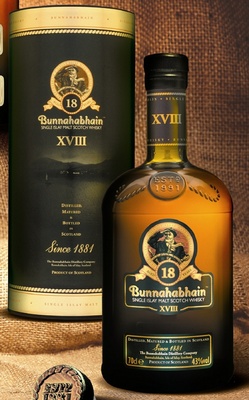|
|
Release Notes
A smooth, slightly sherried dram with all the understated elegance one would expect from the gentlest malt on Islay. The epitome of Bunnahabhain's soft Islay style.
The Whisky Exchange
3rd Party Tasting Notes
Nose: Savlon, pizza dough and red apples. Spray-can paint.
Palate: Astringent, then dry. Burnt pork.
Finish: That lingering burnt meat and a balsa woodiness.
Comment: I couldn't get past that taste of overfried bacon. This is a great malt distillery, and one of my favourites, so I am a little disappointed.
Rating: 7/10
Palate: Astringent, then dry. Burnt pork.
Finish: That lingering burnt meat and a balsa woodiness.
Comment: I couldn't get past that taste of overfried bacon. This is a great malt distillery, and one of my favourites, so I am a little disappointed.
Rating: 7/10
Arthur Motley, Whisky Magazine #54
Nose: Some tart red fruits hover above a buttery, chocolate croissant base. Pleasant malt notes.
Palate: Sweet (green apples?) and fiery at first. Some buttery notes. Warm fruit scones?
Finish: On the short side, with a memory of well done toast.
Comment: A very rich nose is slightly let down in the palate. On the whole, it's respectable enough.
Rating: 7.5/10
Palate: Sweet (green apples?) and fiery at first. Some buttery notes. Warm fruit scones?
Finish: On the short side, with a memory of well done toast.
Comment: A very rich nose is slightly let down in the palate. On the whole, it's respectable enough.
Rating: 7.5/10
Owen Barstow, Whisky Magazine #54
Nose: Woody with evolved fruits; a classic profile. Subtle whiff of citrus in the background. Lovely! A hint of bicycle repair shop. This one loses some steam after a few minutes, but it remains enjoyable.
Taste: Fruity, smooth start; evolving into a solid woody centre.
Some tannins in the (initially) smooth finish. Quite solid. There's a whiff of smoke at the end. The smoothness disappears at the very end, growing dry.
Score: 83 points - surprisingly potent. Clearly a few points 'better' than the 12yo of a few years ago. So, I guess that makes it worth the higher price compared to the 12yo, Toiteach and Darach Ur.
Taste: Fruity, smooth start; evolving into a solid woody centre.
Some tannins in the (initially) smooth finish. Quite solid. There's a whiff of smoke at the end. The smoothness disappears at the very end, growing dry.
Score: 83 points - surprisingly potent. Clearly a few points 'better' than the 12yo of a few years ago. So, I guess that makes it worth the higher price compared to the 12yo, Toiteach and Darach Ur.
Malt Madness
The Distillery: Bunnahabhain
| Established: 1883 |
| Silent since: False |
| Address: Port Askaig, Islay, Argyll, PA46 7RR, Scotland, UK |
| → website |
Based on experiences with single malts from the other distilleries that are owned by Burn Stewart (Deanston and Tobermory) I was sceptical at first. There, the focus seemed to be on quantity rather than quality. It is actually possible to find magnificent bottlings from these distilleries, but they are usually selected casks from independent bottlers. I"m happy to report that Bunnahabhain seems to be doing very well - IMPROVED quality if anything!
The Bunnahabhain distillery on Islay is located on the north of the island, with Caol Ila as its only neighbour. Situated on the coast of the Sound of Islay, it"s protected from the fierce winds blowing in from the Atlantic ocean. Maybe this is reflected in the upeated style of the "Bunny". It"s the only unpeated Islay malt whisky (Bruichladdich is lightly peated).
The fact that Bunnahabhain is (at least potentially) the biggest distillery on the island may come as a surprise to some, but when some of the malt maniacs visited Bunnahabhain in June 2005 we could verify for ourselves that the stills were absolutely massive. The trip to the distillery is worth it, even if you don"t fancy basking in the glow of the massiveness of the stills. Most whisky activity is on the southern part of the island and around Loch Indaal, but a trip north will take you along Loch Finlaggan - worth a detour.
It"s hard to believe if you visit the remote, quiet island of Islay (population +/- 3,000), but it was once the centre of a large empire. The centre of that empire was Loch Finlaggan. In the loch are three islands, two of which lie close to the north shore; Eilean Mor (meaning "large island") and Eilean na Comhairle (council isle) which contain the remains of ancient buildings. The chief of Clan Donald ruled as the "Lord of the Isles".
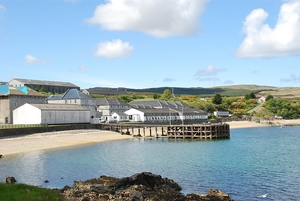
Perhaps it"s just as well that Bunnahabhain was released from their grasp, because both Macallan and Highland Park have managed to drop from my Top 10 of favourite distilleries after the Edrington Group were finished "developing" them. In both cases it meant that the quality of the regular, 12yo expressions that had been affordable favourites of mine during the 1990"s started to drop to "average" levels while the prices were cranked up a notch.
Even though the Bunnahabhain distillery was sold to Burn Stewart, the Edrington group is still its biggest customer. Bunnahabhain may not have the biggest "profile" of the distilleries on Islay, but it has the largest production potential of all distilleries on the island. They don"t run at full capacity, though, making Caol Ila (located just a little to the south) the distillery with the biggest actual annual output on Islay in 2007.
Bunnahabhain distillery was constructed in 1880/1881 by the Greenlees brothers and first opened its doors in 1983. The number of stills was increased from two to four in 1963, at a time that many other distilleries did the same. At the moment, Bunnahabhain has the largest capacity on Islay.
In 1999 Highland Distillers, then the owners of Bunnahabhain, were acquired by the Edrington Group (themselves the result of a merger in 1996). They only held on to Bunnahabhain for a few years; in 2003 Bunnahabhain (the distillery and the brand) were sold to Burn Stewart Distillers, together with the "Black Bottle" brand. In the words of Ian Good, chairman and chief executive of Edrington Group: "The disposals are in line with the group"s strategy of concentrating our investment resource behind developing our core brands." The Glasgow-based Edrington group said that its strategic aim is to concentrate investment behind developing its flagship brands; the Famous Grouse & Cutty Sark blends and the Macallan and Highland Park single malt whiskies.
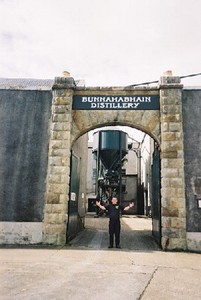
In 2005 Bunnahabhain distillery employed some 11 people. That may not seem like a lot, but on a small island like Islay every job counts. If the workforce of the other Islay distilleries is of a comparable size, that would mean that all Islay whisky is produced by +/- 100 people...
For a while, I had my doubts about Bunnahabhain"s future... The new slogan they came up with at Burn Stewart is "Bunnahabhain - The Spiritual Home of Black Bottle". Well, if that"s the only "core value" they want to express (the fact that Bunnahabhain is used in a blend, albeit a tasty one) they may not be in the best position to take full advantage of the current single malt whisky boom...
In the New Millenium:
2003 - Four years after the Edrington Group mothballed Bunnahabhain in 1999 it was purchased by Burn Stewart, together with the "Black Bottle" brand of peated blended whisky.
2008 - Two brand new "standard" expressions of Bunnahabhain are released; "Darach Ur" and "Toiteach".
Trivia:
- The name Bunnahabhain is Gaelic for "Mouth of the River" and refers to the Margadale River.
- Bunnahabhain"s location was chosen mainly because it"s easily accessible from the mainland by boat.
- Bunnahabhain is one of almost two dozen malt whisky distilleries that were founded over a century ago during the "whisky boom" of the late 19th century and which have managed to survive until this day. The other survivors include Aberfeldy, Ardmore, Aultmore, Balvenie, Benriach, Benromach, Bruichladdich, Craigellachie, Dalwhinnie, Dufftown, Glendullan, Glenfiddich, Glenrothes, Glentauchers, Knockandu, Knockdhu, Longmorn, Tamdhu and Tomatin.
from Malt Maniacs
The Owner: Highland Distillers
| Established: 1887 |
| Silent since: False |
| Address: West Kinfauns, Kinfauns, Perth PH2 7XZ, United Kingdom |
Highland Distillers was founded in 1887 by the Robertson family. In 1970 Highland purchased Matthew Gloag & Son Ltd., producers of the Famous Grouse blended whisky and acquired The Macallan single malt Scotch producers in 1996. Highland also produced the Highland Park brand whisky. Highland Distillers was purchased by the Edrington Group in 1999. William Grant & Sons and the Edrington Group took Highland Distillers private in 2000.
from Wikipedia
The Owner: Edrington Group
| Established: 1961 |
| Silent since: False |
| Address: 2500 Great Western Road, Glasgow, Scotland, G15 6RW, UK |
| → website |
The Robertson Trust bears the family name of the Robertson sisters (Elspeth, Agnes and Ethel) who had inherited the Scotch whisky interests founded and developed by their grandfather and father. Keen to ensure the on-going success of the these interests, in 1961 they brought them together under The Edrington Group (named after a farm near their home in the Scottish Borders) and established The Robertson Trust. The charitable trust is funded to a considerable degree with dividend income from The Edrington Group. The Trust gave £9,900,000 million last year to a wide variety of charitable causes.
The Robertson family was also responsible for founding Highland Distillers back in 1887 and in autumn 1999, Edrington acquired Highland along with its powerful brands The Famous Grouse, The Macallan and Highland Park. These are distributed throughout the world through a series of distribution networks and partnerships.
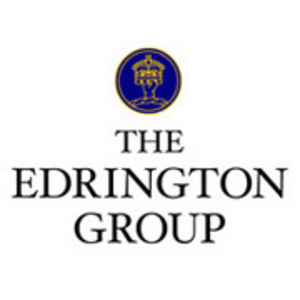
On 3 February 2010 Edrington announced that it had finalised an agreement with Berry Bros. & Rudd (BB&R), under which it will buy the Cutty Sark blended Scotch whisky brand. Under the deal, BB&R will acquire The Glenrothes single malt brand from Edrington, which has signed long-term supply agreements to provide whisky fillings and stocks to BB&R. Edrington will retain ownership of The Glenrothes distillery. The transaction will also involve Edrington acquiring all distribution contracts on Cutty Sark in force at the time of completion. The agreement is due to be concluded by April 2010.
The origins of the Group, based in Glasgow and today one of Scotland"s largest commercial companies, stretch back to the 1850"s when W.A. Robertson began business in the city. Today, Edrington is a Scottish company controlled by The Robertson Trust.

The Famous Grouse is the best selling whisky in Scotland and has held that distinction for the last 29 years. Most recently, Edrington purchased Brugal, a golden rum from the Caribbean. The purchase complements Edrington"s leading portfolio of Scotch whisky brands, and is seen as a natural fit as the Group continues to develop its core brands through premiumisation and by targeting markets with stronger growth potential.
Edrington employs over 800 people at sites across Scotland and 220 in distribution (Nordics, Taiwan and South Korea). Brugal family members continue a 120-year tradition by playing a major role in operating their business, which employs 1,100 people at its various sites across the Dominican Republic.
The Edrington Group Limited is a major Scotch whisky company (now with interests in rum) with expertise in blending, bottling, distributing and marketing. It produces several well-known brands, including The Famous Grouse, and premium malts The Macallan and Highland Park. The portfolio also includes Brugal, the leading golden rum in the Caribbean.
Trivia:
- In the New Year Honours 2008, the Edrington Group"s chair, John James Griffin Good, was made a Knight Bachelor "for services to Scotland".
- In 2010 The Edrington Group acquired the Cutty Sark blended scotch brand from Berry Bros. & Rudd.
from Wikipedia & EdringtonGroup.com
The Owner: William Grant & Sons
| Established: 1886 |
| Silent since: False |
| Address: Phoenix Crescent Strathclyde Business Park, Bellshill, Lanarkshire, ML4 3AN, UK |
| → website |
William Grant & Sons Ltd. is an independent, family-owned Scottish company which distills Scotch whisky and other selected categories of spirits. It was founded in 1886 by William Grant, and is now run by the descendants of the founder. It is the largest of the handful of Scotch whisky distillers remaining in family ownership. "William Grant & Sons" is often abbreviated to "W. Grant & Sons" or just "Grant"s", after their leading blended whisky of the same name.
William Grant & Sons pioneered single malt Scotch whisky as until Glenfiddich, only blended brands were common In 1997 the Grant entered into a joint venture with the Robertson family (The Edrington Group) creating a new company, Highland Distillers.
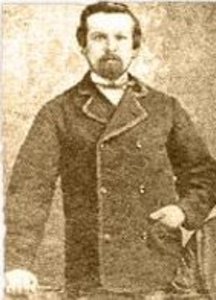
The company"s leading single malt Scotch brand is Glenfiddich, the best-selling brand in the worldwide single malt Scotch market (700,000 cases/year and 17.37% market share). This is more than the sales of the next two single malts combined. Their leading blended Scotch brand is Grant"s, the 4th best-selling brand in the worldwide blended Scotch market and the Scotch market as a whole (4 million cases/year). Grant"s is also the 4th best-selling brand in the domestic United Kingdom Scotch market (420,000 cases/year and 14.6% market share).
William Grant was born in Dufftown in 1839. The young Grant worked at Mortlach Distillery and dreamed of one day running his own distillery. He worked hard and saved and in 1886 Grant and his 9 children laid the first stone of the Glenfiddich Distillery. It was Christmas day 1887 when the first spirit ran from the stills.
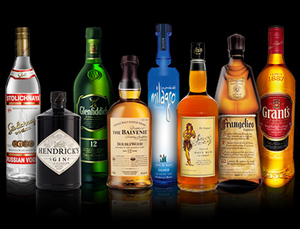
In 1892 William Grant & Sons bought a second neighbouring Distillery called Balvenie. In 1898 the two distilleries started blending their whiskies and Grant"s Whisky was "born".
The company is the 3rd largest producer of Scotch whisky (10.4% market share) after Diageo (34.4%), and Pernod Ricard. The company"s central headquarters are in Strathclyde Business Park, North Lanarkshire. Sales and marketing headquarters are in Richmond, London. The company is a member of the Scotch Whisky Association.

The master blender of Grant"s is David Stewart, who has been in his post for 47 years, the longest serving master blender with one distiller in the industry.
Core brands include: Glenfiddich, Grant"s, Balvenie, Hendrick"s Gun, Sailor Jerry Rum. Other brands include: Reyka Iclandic Vodka, Sailor Jerry Spiced Rum, Old Vatted Demerara Rum, Wood"s 100 Old Navy Rum, Vat 19 Rum, Gibson"s Finest, Clan MacGregor Blended Whisky, Monkey Shoulder Triple Malt Whisky, Taboo, Milagro Tequila, Solerno. The company also produces a number of rare whiskies such as Girvan First Batch (from 1964 casks) and Ladyburn (silent distillery closed in 1975) as well private vintage bottlings. Via Highland Distillers the company has a stake in the following brands: The Famous Grouse, The Macallan, Highland Park, Black Bottle and Gloag"s Dry Gin. The company has also co-developed Virgin Vodka with Richard Branson"s Virgin Group
The company owns several distilleries including Glenfiddich, Balvenie, Girvan Grain Distillery, Convalmore (only the bonded warehouse), Kininvie and Ailsa Bay Distillery.
Trivia:
- allegedly the first company to market Scotch whisky abroad (this claim is very contentious - there are several, particularly Glen Grant and Glenmorangie, which would dispute it)
- revolutionized bottle design in the 1950s, creating a triangular bottle
- was the first to open up its distillery to visitors
- introduced the solera concept to Glenfiddich to create Glenfiddich Solera Reserve
from Wikipedia
